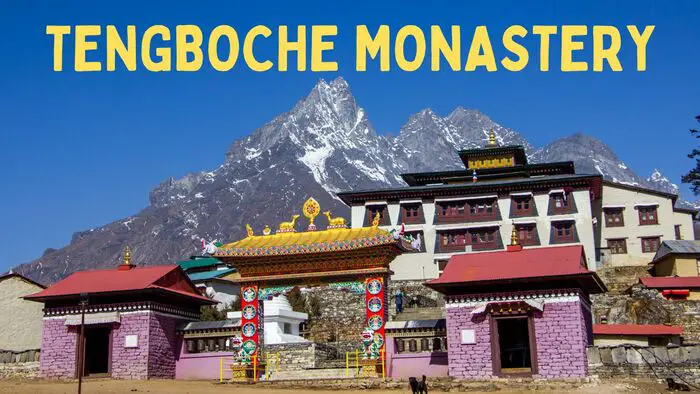Amidst the cluster of monasteries in the area, Tengboche Monastery occupies a prominent position as a key Buddhist institution. It is celebrated for its profound cultural and historical importance.
Reverently referred to as Tengboche Monastery or Thyangboche Monastery, and also bearing the name Dawa Choling Gompa. The Tibetan Buddhist sanctuary resides within the Tengboche village of Khumjung, nestled in Nepal’s Khumbu region. Positioned at an elevation of 3,867 meters (12,687 feet), this monastery is one of the largest gompa within the Khumbu expanse. Its foundations were laid in 1916 by Lama Gulu, with deep-rooted ties to its counterpart, the Rongbuk Monastery in Tibet.
Sitting in the Sagarmatha National Park, an esteemed UNESCO World Heritage Site Tengboche Monastery offers a backdrop of the Himalayan panorama. This breathtaking vista encompasses iconic peaks such as Tawache, Mount Everest, Nuptse, Lhotse, Ama Dablam, and Thamserku.
Tengboche plays a pivotal role as the culminating point of the “Sacred Sites Trail Project” within the Sagarmatha National Park. Encompassing a circular path that touches 10 monasteries in a clockwise trajectory. The journey culminates in the revered halls of Tengboche Monastery, casting an enduring allure for pilgrims and trekkers alike.
Quick Information on Tengboche Monastery
| Place | Rumdu |
| Established | 1916 |
| Founded by | Lama Gulu |
| Religious Affiliation | Tibetan Buddhism |
| Location | Khumjung, Khumbu |
| Elevation | 3,867 meters/ 12, 687 ft |
| Architecture Style | Tibetan |
| Major Festival | Mani Rimdu |
Where is Tengboche Monastery?
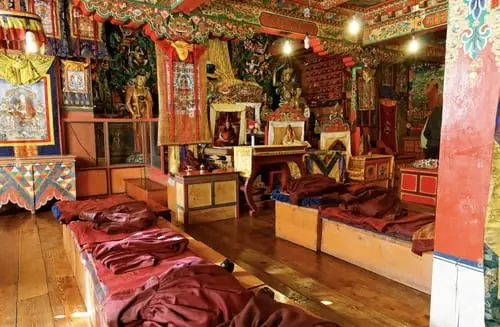
Tengboche Monastery is situated in the Tengboche Village within Khumjung, Nepal. This sacred establishment holds significance for trekkers along the path to Everest Base Camp.
Nestled within the Sagarmatha National Park, the monastery resides within the Everest Region, also known as the Khumbu Region, necessitating the acquisition of a permit for entry. Notably, Tengboche finds its location within the Mahalangur Himalayan sub-range, a distinctive segment of the overarching Himalayan mountain range.
History of Tengboche Monastery

About 350 years ago, the Khumbu valley, which now houses the monastery, underwent a significant transformation with the infusion of Buddhism. Historic Tibetan texts mention the sanctity attributed to this valley, alongside the Rowlang and Khanbalung valleys.
Lama Sangwa Dorje emerged as a pivotal figure, credited not only as the initiator of the oldest Pangboche Monastery in Khumbu but also as the founder of several smaller hermitages. Lama Sangwa Dorje’s extraordinary insight and visionary abilities led to the prophetic revelation that Tengboche held a conducive environment for a monastery. A revelation he marked with a meditative footprint on a rock.
However, the materialization of this vision took shape during the era of Ngawang Tenzin Norbu. Recognized as the fifth incarnation of Lama Sangwa Dorje. Ngawang Tenzin Norbu, who had earlier established the Rongbuk Monastery on the northern slope of Mount Everest in Tibet, bestowed his blessings upon Chatang Chotar, known as Lama Gulu.
Lama Gulu, undertook the mission of founding the Tengboche Monastery in the Tengboche village. This sacred edifice was finally established at its current site in 1916. Notably, it holds the distinction of being the premier celibate monastery within the Nyingmapa lineage of Vajrayana Buddhism. Several venerable monastic institutions exist in close proximity, adding to the spiritual landscape of the region.
Funding and Foundations of Tengboche Monastery
The financing for the monastery’s construction is attributed to three affluent members of the local Sherpa community. Notably, Karma, a prominent figure among these individuals, held significant sway due to his role as a tax collector, while also enjoying favor from Nepal’s ruling Rana dynasty. The monastery’s construction also saw the participation of Sherung Sherpas, extending its collaborative foundation beyond the Khumbu Sherpas.
Evidence of the region’s religious legacy predates back to 1880, evident through the presence of village temples, chortens (stupas), and smaller religious sanctuaries. Particularly noteworthy are the substantial chortens, some of which trace their origins to this period. Additionally, the Mani wall, characterized by inscribed stone slabs bearing prayers and sacred texts, holds a history dating back to 1915.
Earthquake of 1934
The 1934 earthquake devastated the monastery, and its original builder, Lama Gulu, passed away. The responsibility of reconstruction fell upon his successor, Umze Gelden, who received robust assistance from Ngawang Tenzin Norbu.
Together with a proficient carpenter from Lhasa, the monks and local community diligently rebuilt the monastery. Renowned artist Kappa Kalden adorned the walls with distinctive murals. The monastery gained substantial acclaim due to the burgeoning tourist influx in the Khumbu region, especially from mountaineering enthusiasts drawn to trekking.
Electrical Fire of 1989
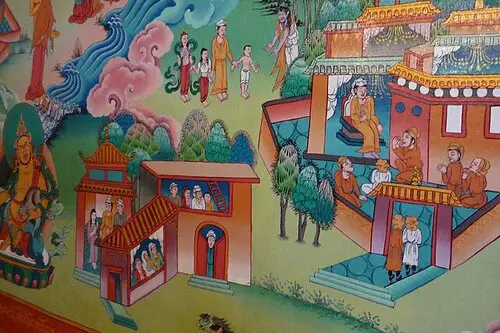
Nevertheless, a devastating fire on January 19, 1989, ignited by an electrical short circuit, obliterated the monastery’s invaluable ancient scriptures, statues, murals, and wood carvings.
The structure showcased exquisite traditional Sherpa architecture adorned with masterfully painted artworks. The monastery’s design and its breathtaking surroundings encapsulated the monastic way of life. Regrettably, the fire inflicted significant harm, ravaging relics, inscriptions, and artifacts, thereby disturbing the precious rare texts and murals.
Even the monumental stone imprinted with Lama Sangwa Dorje’s footfall suffered fractures. A handful of trekkers salvaged a portion of the books and artworks. After the monastery’s fire-induced destruction, the task of reconstruction was led by Nawang Tenzing Jangpo, the incarnation of the founder Lama Gulu. Sherpa residents from Khumjung, Kunde, Phortse, Pangboche, and Namche Bazaar united to offer their services and expertise for the monastery’s rebuilding. Additionally, through worldwide contributions, the monastery was entirely reconstructed in the aftermath.
Earthquake of 2015
In 2015, Nepal experienced a catastrophic earthquake that inflicted widespread damage on numerous monuments, including Tengboche Monastery which also suffered partial harm. Subsequent efforts were made to repair the damages within the monastery. Following the completion of the reconstruction in 2017 the monastery was reopened to the public.
Mani Rimdu Festival in Tengboche Monastery
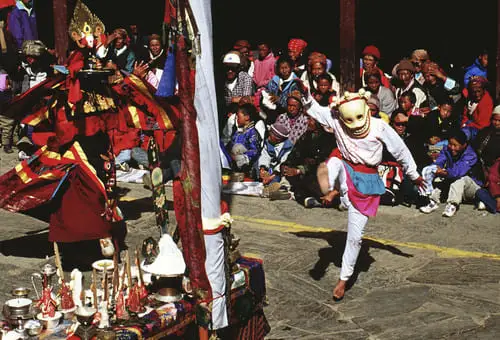
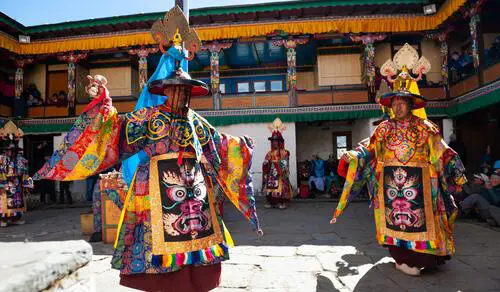
Mani Rimdu stands as the Sherpa people’s most significant festival. It occurs during the tenth lunar month in the Tibetan calendar, equivalent to October–November in the Gregorian calendar. This celebration coincides with the autumn season, which witnesses a surge of tourists visiting the Khumbu region for Everest Base Camp trekking and to partake in the nineteen-day festival.
Mani Rimdu began in the early 1900s at Rongpuk Monastery in Tibet, under the direction of Ngawang Tenzin Norbu. Many of the rituals encompassed within Mani Rimdu are rooted in the practices of Mindroling Monastery, a prominent Nyingma institution in Central Tibet.
The festival encompasses various religious observances and meditation practices (Drupchen). “Mani Rimdu” holds the connotation of “Mani,” signifying a portion of Chenrezig’s chant, and “Rilbu” or “Rimdu,” referring to small red pills sanctified during the event. These pills are repeatedly blessed and subsequently distributed among the attendees.
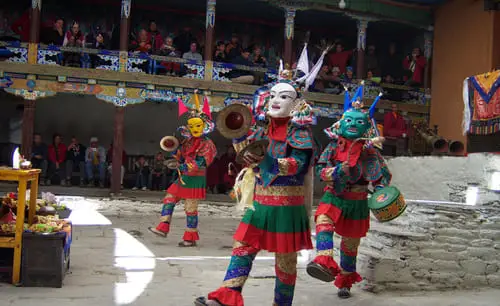
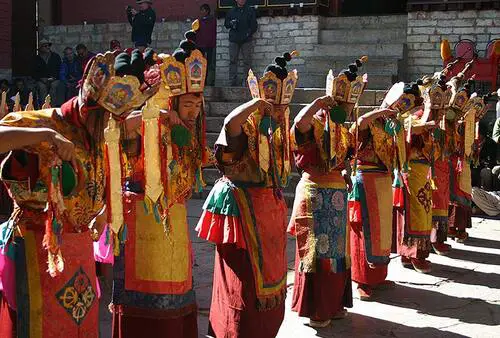
Passed down from its mother monastery, Rongbuk, the festival’s commencement features an intricate depiction of a sand mandala, crafted over four days using sand extracted from designated hills. This mandala remains central to the ten-day religious festivities.
The program entails sixteen dance performances interspersed with comical interludes. Concluding the event, the resident Tengboche Rinpoche blesses the general public, followed by monks performing ‘Mask Dances.’ These dances embody protective deities, emanations of Guru Rinpoche, the Tibetan Buddhism founder, and portray the subjugation of demons and the dissemination of Buddhism in Tibet.
Tengboche Monastery and Mani Rimdu jointly serve as prominent tourist attractions in Nepal, drawing around 15,000 visitors annually, with peak seasons witnessing up to 600 tourists per week.
How Do I Get To Tengboche Monastery?

Getting to Tengboche Monastery requires a tough three-day hike from Lukla. However, considering the need for acclimatization due to the high altitudes, many opt for a four-day trek.
The trail initially crosses the Dudh Kosi river at 3,250 meters (10,660 feet), followed by an uphill climb to reach Tengboche Monastery situated at an elevation of 3,870 meters (12,700 feet). Subsequently, a descent leads to Devouche, housing the nunnery.
Tengboche serves as a pivotal midway point on the path to the base camp for Mount Everest climbers. These regions collectively encompass the expansive Khumbu area extending up to the Tibet border. Which cover an area of 1,148 square kilometers (443 square miles). The Khumbu area also includes the entirety of the Sagarmatha National Park.
Can You See Everest From Tengboche Monastery?
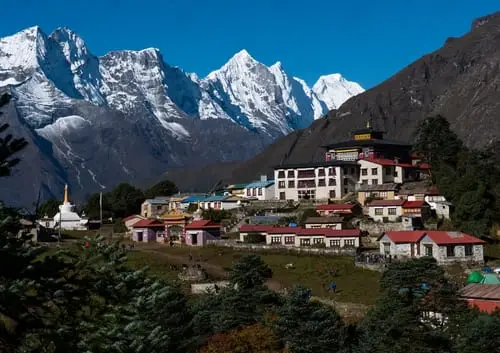
Yes, you can see Everest from Tengboche Monastery. Additionally, Tengboche presents expansive panoramic vistas of numerous other mountains in the region. It’s important to note that, along the Everest Base Camp trek, the sight of Everest usually entails observing its summit rising above the surrounding snow-capped peaks. Instead of the entire mountain due to the perspective from various vantage points along the trail.
Best Time To Visit Tengboche Monastery
The best time to visit Tengboche Monastery is between mid-October and mid-November, when the Mani Rimdu festival is celebrate. This timeframe promises a rich cultural experience amidst the Khumbu highlands of Nepal.
For a general visit to the monastery, the prime times are the spring and autumn seasons. During these periods, the weather remains moderate, the temperatures are pleasant, and visibility is optimal. This setting provides an excellent opportunity to explore the stunning mountain landscapes while immersing yourself in the unique Sherpa culture of Nepal.
